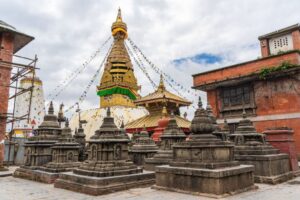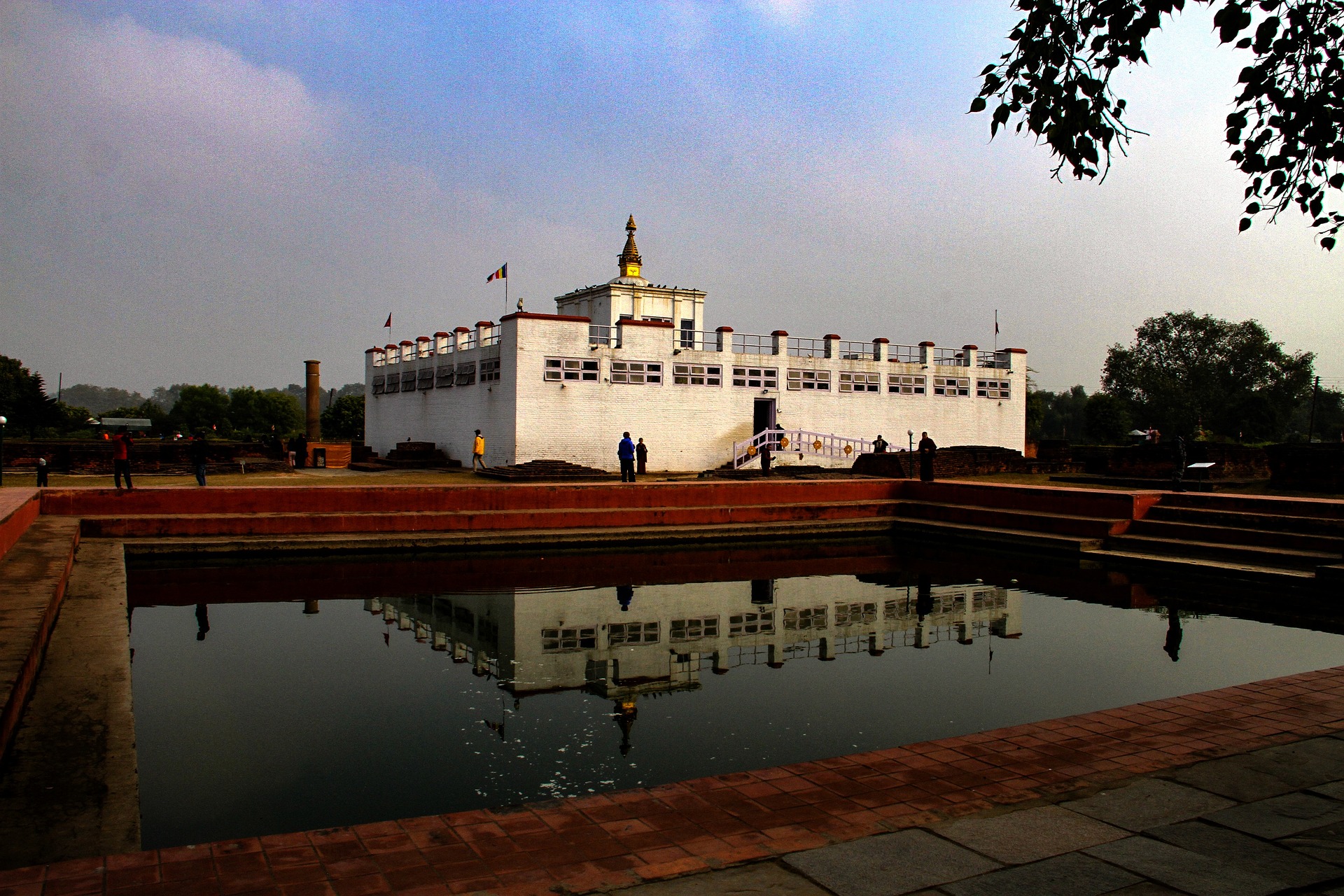Buddhist Pilgrimage Sites in Nepal hold a special place in the hearts of devotees and spiritual seekers alike. Embarking on a Buddhist pilgrimage tour through the picturesque landscapes of this Himalayan nation is a transformative journey of self-discovery. The first leg of this sacred sojourn often begins in Lumbini, the birthplace of Lord Buddha. Here, within the serene confines of the sacred garden, Maya Devi Temple, and other historical sites, pilgrims find solace and inspiration as they follow in the footsteps of Siddhartha Gautama.
Continuing the pilgrimage, the next stop beckons at Swayambhunath, known as the Monkey Temple, a UNESCO World Heritage Site perched high above Kathmandu Valley. This iconic stupa not only offers panoramic views but also a profound sense of spirituality. The journey further leads to Boudhanath Stupa, where the all-seeing eyes of the Buddha watch over the faithful as they engage in the timeless practice of circumambulation. Lastly, the spiritual quest takes you to Kapilvastu, a tranquil town where Prince Siddhartha spent his formative years. Visiting these Buddhist pilgrimage sites in Nepal is not merely a historical exploration; it’s a soul-stirring experience that connects the pilgrim to the profound teachings and enlightenment of Lord Buddha. Here are 10 must-visit Buddhist Pilgrimage sites in Nepal:
Lumbini
Lumbini is the birthplace of Lord Buddha, the founder of Buddhism. It is one of the four holy places of Buddhism, along with Bodh Gaya, Sarnath, and Kushinagar. It is by far the most revered Buddhist pilgrimage sites in Nepal and worldwide. Lumbini is located in the Terai region of Nepal, near the Indian border. It has been a UNESCO World Heritage Site since 1997.
Lumbini has a historical and religious significance for Buddhists all over the world. It is where Queen Maya Devi gave birth to Prince Siddhartha Gautama under a sal tree in 623 BCE. According to legend, as soon as he was born, he took seven steps in each direction and declared that he was the supreme being. He later renounced his royal life and attained enlightenment as Buddha.
Lumbini offers many attractions for visitors, such as the Maya Devi Temple, which marks the exact spot of Buddha’s birth. The temple contains a stone image of Maya Devi holding a branch of the sal tree and a stone slab representing Buddha’s birthplace. There are also several monasteries, stupas, museums, and gardens that reflect the diversity of Buddhist traditions and cultures.
Boudhanath Stupa
Boudhanath Stupa is one of the largest and most iconic Buddhist stupas in the world. It is located in Kathmandu, the capital city of Nepal. It has also been a UNESCO World Heritage Site since 1979.
Boudhanath Stupa has a cultural and spiritual significance for Buddhists, especially for Tibetan Buddhists who consider it as their second home. It is said to be built in the 5th century CE by King Manadeva to honor an incarnation of Buddha. It is also believed to contain relics of Buddha and his disciples.
One of the most visited Buddhist pilgrimage sites in Nepal, Boudhanath Stupa has an impressive architecture and symbolism. It has a white dome that represents the earth, a square base that represents the four directions, a spire that represents the thirteen stages of enlightenment, and a pair of eyes that represent Buddha’s wisdom and compassion. The stupa is surrounded by prayer wheels, flags, statues, monasteries, shops, and restaurants that create a vibrant atmosphere.
Swayambhunath Stupa

Swayambhunath Stupa is another famous and ancient Buddhist stupa in Kathmandu. It is also known as the Monkey Temple because of the presence of monkeys that live in the nearby forest and is one of the most famous Buddhist pilgrimage sites in Nepal. It has also been a UNESCO World Heritage Site since 1979.
Swayambhunath Stupa has a historical and religious significance for Buddhists and Hindus alike. It is said to be one of the oldest religious sites in Nepal, dating back to the 5th century CE or earlier. It is also said to be self-created or self-existent, hence the name Swayambhu, which means “self-born” or “self-manifested” in Sanskrit.
Swayambhunath Stupa has a similar architecture and symbolism as Boudhanath Stupa, but with some differences. It has a golden spire that is adorned with colorful flags and jewels. It also has a large stupa complex that includes several shrines, temples, statues, and museums that showcase the diversity of Nepalese culture and religion.
Tilaurakot
Tilaurakot is a significant historical site associated with Lord Buddha’s life. It is located in Kapilvastu district, about 25 km from Lumbini. Often overlooked, Tilaurakot is a very important Buddhist pilgrimage sites in Nepal. UNESCO has listed it in the list of Tentative World Heritage Sites.
Tilaurakot has an archaeological and cultural importance for Buddhists. It is where Siddhartha Gautama, the prince who later became Buddha, spent his childhood and youth. It was the capital of the ancient Shakya kingdom, where his father, King Suddhodana, ruled. The site was also the place where he renounced his worldly life and left for his spiritual quest.
Tilaurakot offers many attractions for visitors, such as the remains of the palace complex, the eastern and western gates, the moat, the fortification walls, and the ponds. There are also several excavated structures, such as temples, monasteries, stupas, and shrines that date back to the 6th century BCE to the 4th century CE.
Kapan Monastery
Kapan Monastery is a center for Tibetan Buddhism in Kathmandu Valley. It is located on a hilltop near Boudhanath Stupa. It was founded in 1971 by Lama Thubten Yeshe and Lama Zopa Rinpoche, two renowned Tibetan Buddhist masters.
Kapan Monastery has a role in Buddhist teachings and meditation. It is affiliated with the Foundation for the Preservation of the Mahayana Tradition (FPMT), an international organization that promotes Tibetan Buddhism worldwide. It offers various courses, retreats, and programs for visitors who want to learn more about Buddhism and practice meditation.
Kapan Monastery also provides insights into the daily life of monks at Kopan. There are about 360 monks who live and study at Kapan Monastery. They follow a strict schedule of prayers, rituals, debates, classes, chores, and meals. They also engage in social service activities such as running a school, a clinic, an orphanage, and an animal shelter.
Namobuddha Monastery
Namobuddha Monastery is a sacred site associated with Lord Buddha’s past life. It is located in Kavre district, about 40 km from Kathmandu. It is also known as Thrangu Tashi Yangtse Monastery1.
Namobuddha Monastery has a historical and spiritual importance for Buddhists. It is where Prince Mahasattva, a previous incarnation of Buddha, sacrificed his own flesh to feed a starving tigress and her cubs. According to legend, the bones of the prince were buried at the site and later a stupa was built to commemorate his noble deed. The stupa is believed to contain the relics of Buddha and his disciples.
Namobuddha Monastery has a serene ambiance and meditation opportunities. It is surrounded by green hills, forests, and fields that offer a peaceful retreat from city life. It is also home to more than 250 monks who follow the Tibetan Buddhist tradition. They offer various courses, retreats, and programs for visitors who want to learn more about Buddhism and practice meditation.
Pharping Yangleshö Cave Monastery
Pharping Yangleshö Cave Monastery is a hidden gem in Kathmandu Valley. It is located in the village of Pharping, about 20 km from Kathmandu. It is also known as Asura Cave or the Upper Cave of Yangleshö1.
Pharping Yangleshö Cave Monastery has a historical significance as a meditation retreat. It is where Guru Padmasambhava, the second Buddha, meditated and accomplished Vajrakilaya, a deity associated with the Buddha’s enlightened activity and renowned for the removal of obstacles to awakening2. It is also said that Guru Padmasambhava combined the practices of Yangdak Heruka and Vajrakilaya at this cave and attained the ultimate fruition of Mahamudra, the Great Seal3.
Pharping Yangleshö Cave Monastery has a spiritual connection to Guru Rinpoche. It is one of the most sacred sites connected with his activity outside Tibet3. It contains a self-arisen image of Guru Rinpoche on the cave wall and a footprint of his consort, Princess Mandarava.
Tengboche Monastery
Tengboche Monastery is a prominent Buddhist monastery in the Everest Region. It is located in the Khumbu district, about 126 km from Kathmandu. It is situated at an altitude of 3,867 m, on a ridge overlooking the stunning views of Mount Everest, Lhotse, Ama Dablam, and other peaks. As thousands of tourists flock to Everest every year, Tengboche is one of the most visisted Buddhist pilgrimage sites in Nepal.
Tengboche Monastery has a historical and cultural significance for Buddhists, especially for Sherpas who inhabit the region. It was founded in 1916 by Lama Gulu, a renowned Tibetan Buddhist master. It belongs to the Nyingma sect of Tibetan Buddhism and is the largest monastery in the Khumbu area.
Tengboche Monastery is famous for hosting the Mani Rimdu Festival, which is a colorful and lively celebration of Buddhist culture and traditions. The festival takes place every year in October or November, depending on the lunar calendar. It lasts for 19 days and involves various rituals, dances, prayers, and offerings. The highlight of the festival is the masked dance performed by the monks, which depicts the victory of good over evil.
Shey Gompa
Shey Gompa is a remote and pristine Buddhist site in Dolpa. It is located in the Upper Dolpo region, near the Tibetan border. It is also known as the Crystal Monastery.
Shey Gompa has a historical and cultural significance for Buddhists, especially for the Bonpo sect of Tibetan Buddhism. It was founded in the 11th century by a Tibetan Buddhist master named Zhang Zhung Nyima Gyaltsen. It is one of the oldest and most sacred Bonpo monasteries in Nepal. The monastery is also a center of pilgrimage for devotees who seek the blessings of the Crystal Mountain, a holy mountain that is said to be the abode of a powerful deity named Sipé Gyalmo.
Shey Gompa has an ancient monastery and a spiritual atmosphere. It has a main temple that contains a statue of Sakyamuni Buddha and various paintings and sculptures. It also has a stupa that contains relics of Buddha and his disciples. The gompa is surrounded by a barren landscape, which gives it a mystical aura.
Chhairo Gompa
Chhairo Gompa is a lesser-known but significant Buddhist site in Mustang. It is located in the village of Chhairo, about 20 km from Jomsom. Chhairo Gompa has a historical and spiritual importance for Buddhists, especially for the Nyingma sect of Tibetan Buddhism. Established in the 16th century by Lama Chhawang Thinlen, a renowned Tibetan Buddhist master, it was the first Nyingma monastery founded in Mustang. It was also a center of learning and culture for the local people.
Chhairo Gompa has unique architecture and art. It has a two-story building colored in red and the interior has various Buddhist paintings. It also has a stupa that contains relics of Buddha and his disciples. The gompa is surrounded by a grove of juniper trees, which give it a tranquil atmosphere.
Conclusion
Nepal is a country with a rich Buddhist heritage that spans over two millennia. It has some of the most sacred and ancient Buddhist sites in the world, where you can witness the history, culture, and traditions of Buddhism. These sites will also offer you stunning views, serene ambiance, and unique experiences that will enrich your mind and soul.
Whether you are a devout Buddhist or a curious traveler, these ten must-visit Buddhist pilgrimage sites in Nepal are worth visiting at least once in your lifetime. They will not only give you a glimpse of the life of Buddha and his teachings, but also of the diversity and harmony of Nepalese people and their faith.

